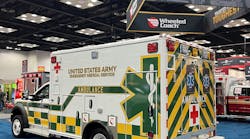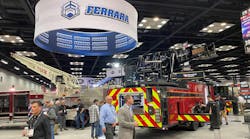Fire pump primers may not be glamorous, but priming systems are critical to pump drafting performance. Pulling a prime quickly is key to fast water delivery, a basic fireground necessity. Last month, we answered several questions about pump priming. This month, we will continue our look at priming systems by reviewing commonly found priming problems. Priming System Integrity
After excessive lift is eliminated as a "no-prime" problem, a recurring no-prime condition can occur due to a variety of reasons. To weed out problems, a good place to start is in the maintenance shop, checking the integrity of the priming system. First, perform cursory checks to see if:
1. There is lubricating oil in the primer reservoir. (If the primer is using an excessive amount of lubrication, check to see if the vent hole in the oil line that functions to prevent a siphon is blocked.)
2. The priming valve is working correctly.
3. The power and electrical connections to the electric primer motor are sound.
Now go beyond that and see what gauge wire is connected to the primer motor/solenoid. How long is the power cable? Is the wire gauge sufficient for its total length in feet versus its amp carrying capacity? (Check with the primer manufacturer for wire-gauge/amp draw/total length requirements.) Does the primer motor have a good ground connection? A primer needs a good electrical supply and a properly sized electrical connection to work correctly and keep on working over time.
In addition to the above items, one reason for not being able to prime the pump is a damaged electric vacuum primer that does not turn, or if turning, is worn and not able to "pull" the required amount of vacuum.
Vacuum Primer Test
To test for a worn or damaged primer in the maintenance shop, isolate the primer by disconnecting the vacuum primer/fire pump tubing connection at the vacuum priming pump. Connect a manometer or master vacuum gauge to the primer. Activate the primer and see how deep a vacuum it will pull. The National Fire Protection Association (NFPA) 1901 guideline is that vacuum primers need to attain at least 22 inches of mercury (in. Hg). See how the vacuum reading stacks up against both NFPA minimum requirements and the primer's original vacuum specification available from the manufacturer. Repair or replace the priming pump as required.
If a no prime condition still persists when drafting from a static water source, air leaks into the fire pump are the likely culprit. Here are some common reasons for air leaks into the fire pump:
- The pump operator left pump discharge, suction or drain valve(s) in the "open" position
- Fire pump suction cap(s) are loose or have bad gasket(s)
- The pump's discharge and suction valves leak, even in the fully "closed" position
- The pump's external relief valve(s) may be damaged and leak
- The pump casing, flanges, and discharge or suction manifold piping have pinholes, the pump shaft seal leaks, the pump shaft packing needs adjustment or a gasket is defective
- Hard-sleeve suction hose has pinholes, has bad gaskets at connections, couplings leak or connections are loose
Pump, Manifold and Suction Hose Assembly Vacuum Test
Once the above causes of air leaks are checked and any obvious deficiencies are corrected, it is a good idea to run a "vacuum test" on the entire pump and suction assembly. To do this:
- Fully charge the truck batteries
- Drain the pump and close the tank-to-pump valve
- Install the suction hose you normally use on the intake of the fire pump
- Cap the end of the suction hose
- Remove all caps from the fire pump's discharge valves (keep the discharge valves in the "closed" position)
- Open all pump suction valves and cap every pump intake opening
- Check and clean out the test gauge connector line
- Connect a manometer to the test gauge connector line
- Run the primer until the vacuum reading is 22 in. Hg (or greater, as stated by the primer manufacturer's original specifications)
- Over the next five minutes, watch the manometer to see if or how far the reading drops
NFPA 1901 contains the following guidelines for a vacuum test: "The vacuum shall not drop more than 10 in. Hg in five minutes. The primer shall not be used after the five-minute test period has begun." If the vacuum drops faster than 10 in. Hg in five minutes, look for and correct any additional air leaks. Even though you may meet the NFPA minimum leakage requirement, a small air leak in the wrong spot will reduce pump performance. Preferably, your performance should exceed the minimum set by NFPA. In reality, this 10 in. Hg. in five minutes was allotted for pump shaft packing adjustment and not for plumbing or valve leaks! If a mechanical seal is installed on your pump, the vacuum drop over a five-minute period should be insignificant.
During the test, major air leaks normally cause a hissing sound and can be located just by listening for them. A leak in a discharge valve can be located by placing the palm of your hand over the discharge outlet for about 30 seconds. If there is a vacuum leak, suction can be felt on your hand. (Do not open the valve while your hand is on it - serious injury can occur!) If you believe you have several small air leaks in the suction hose assembly after the vacuum test, you can use water to pressurize the suction hose and fittings and check for leaks, but be careful not to exceed the maximum pressure recommended by the suction hose manufacturer. Vacuum testing the suction hose alone is also good idea because some pinholes in the hose may self-seal under pressure.
Priming Time Test
Now that you have repaired all the air leaks and the vacuum test proves satisfactory, it's time to drop the suction hose in a static water source for a priming time test. NFPA 1901 recommends: "The time required to prime the pump shall not exceed 30 seconds if the rated capability is 1,250 gpm or less. The time to prime the pump shall not exceed 45 seconds if the rated capacity is 1,500 gpm or more. An additional 15 seconds shall be permitted to meet these requirements when the pump system includes an auxiliary four-inch or larger intake pipe."
If you own a 1,500- or 2,000-gpm midship pump that has a large-diameter suction connection at the front or rear of the apparatus, expect lengthened priming times. Suction and discharge piping manifolds found on industrial foam pumpers also contain large volumes of air.
Other reasons for extended priming times (beside large piping manifolds) are a damaged primer pump electric motor (which runs the priming pump under-speed) or a damaged priming pump (caused by a stuck rotary-vane in the priming pump rotor, or a priming pump that ingested a large amount of solid particulate). Check these out and repair or replace the components.
Question: During some of our drafting operations, we prime the pump, start to move water and then immediately lose prime. Why does this occur?
Many times, it is because of an air trap in the suction hose. If you have quite a few lengths of hard-suction hose off the pump into a static water supply, and the elevation of the hose does not follow a downward slope from the pump to the water source, an air trap occurs. Even though the suction hose has this air trap, it is still possible to initially prime the pump. However, the air pocket stays trapped inside the suction hose. As soon as the fire pump discharges a significant volume of water, flow in the suction hose increases and sweeps the air pocket up into the pump, resulting in a temporary loss of prime. Try to avoid suction hose air traps - if they are unavoidable, immediately re-prime the pump.
Another reason for loss of prime is a whirlpool developing by the suction strainer. This lets air enter the suction hose, causing a temporary loss of prime. Debris can also block flow into the suction strainer resulting in lost prime.
Question: Every so often, when we set up a drafting operation, we prime the pump, start discharging water and find pump pulsation (air in the discharge water). What causes this?
Constant pump pulsation or a ragged discharge stream indicates that air is being entrained in the water flow at some point in the suction side of the pump. This can happen after a pump achieves a prime and moves water, even though there are air leaks in the suction assembly. The result is lowered pump efficiency and reduced maximum pump capacity. This problem magnifies itself on lifts that are higher than normal and at high altitudes. Find and fix the air leaks in the suction hose fittings or assembly. A ragged discharge stream can also occur because of a whirlpool at the suction hose strainer allowing air to enter the suction hose and pump.
Question: What steps must we take to maintain our priming system?
Recommendations for each priming system vary by manufacturer. Ask for testing and maintenance information. Make priming system checks an integral part of your scheduled fire pump preventative maintenance and testing program. Failing to care for your priming system is foolish. If your priming system fails because of benign maintenance neglect, your engine could be useless the next time drafting is required. A few suburban departments have been lulled into a false sense of security because their fire districts have lots of hydrants and therefore they don't need to use the primer much.
While a priming system is an important fire pump accessory, it is often thought of secondarily when planning apparatus specifications, and not given adequate attention during pump testing and maintenance. Good priming system design, installation and maintenance are critical for effective drafting operations. Make sure your priming system, fire pump and pump operation training are up to par to prevent a fireground catastrophe.
PRIMING SYSTEM DIAGNOSIS: SYMPTOMS & POSSIBLE CAUSES
Priming pump electric motor doesn't turn.
- Dead battery
- Main power feed wire has bad connections
- Bad electric primer motor ground
- Bad master disconnect switch or solenoid
- Solenoid switch which activates primer is bad
- Wiring to control solenoid had bad connections or is disconnected
- Defective solenoid
- Defective motor
- Defective switch on priming valve
Vacuum priming pump is slow to pull a prime or priming maximum vacuum is lower than normal (vacuum holds).
- Low charge on batteries
- Batteries not sufficient size
- Cable between battery and primer insufficient size
- Electrical connectors on cable dirty
- Bad ground
- Extremely large quantity of suction hose or suction piping
- Too small or too long a length of piping between primer and pump
- Priming valve not fully opening (operator error)
- Lift is too high
- Primer vanes worn
- Loose or broken V-belt (on belt driven primers)
Priming pump can pull some prime, but it will not hold vacuum.
- Air leaks somewhere in the system
- Bad suction hose gasket
- Pump or discharge drain was left open
- Gauge or drain tubing line disconnected
- Leaking or stuck priming valve
- Priming valve seat defective
- Leaking suction relief valve
- Rusted-out piping
- Leaking suction hose
- Bad mechanical seal
- Leaking packing
- Bad flange gasket on pump
- Cracked or broken casting
Can pull full prime, it holds, but pump loses water when you start to pump, or pump cavitates prematurely, or pump cavitates at high pressures.
- Pump impeller is damaged or severely worn out
- Suction hose not submerged in adequate water supply
- Air leak during water flow (see list directly above).
- Clogged inlet strainer on pump suction hose
- Pump impeller pre-rotation baffle is missing
- Air pocket in piping or air trap in suction hose
- Air accumulation in piping
- Turbulence in piping
- Too much vertical distance to water source and/or, too many lengths of suction hose
- Failing (collapsing) suction hose
DOMINIC COLLETTI is the author of The Compressed Air Foam Systems Handbook and Class A Foam - Best Practice for Structure Firefighters. He is co-author of Foam Firefighting Operations 1 and The Rural Firefighting Handbook. Colletti is a former assistant fire chief and serves on the technical committee of NFPA 1500 Fire Department Occupation Safety and Health Program. He is the Global Foam Systems Product Manager for Hale Products and can be reached at [email protected].





